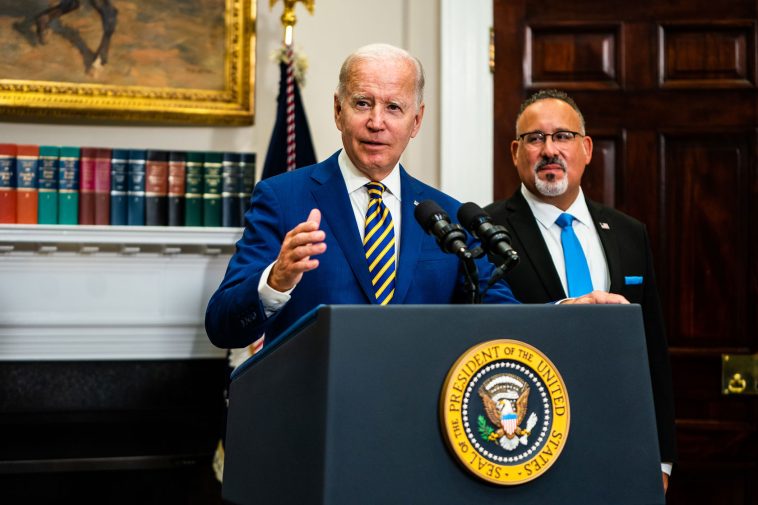Despite Joe Biden’s repeated promises to ease the burden of student loans, he continuously underperforms in devising effective relief plans. The president’s primary proposal – to forgive at least $10,000 in loan debt for the majority of borrowers – met a formidable wall of opposition within the Supreme Court in 2023. In response to this setback, a desperate administration launched smaller-scale efforts. Unfortunately for Biden, even these minor endeavors have often been challenged legally, revealing an administration in disarray over an issue they claimed to tackle competently.
An ill-considered plan brewed in April by Biden’s administration to forgive loans for approximately 30 million Americans has faced more than its share of troubles. The flawed effort, relying on the Higher Education Act, has been barraged by legal hurdles, indicative of the haphazard strategy behind it. The hearing on this hastily implemented plan, scheduled for September 18, will likely further expose its weaknesses in its ambitions overreaching the legal safeguards.
Rubbing salt in their wounds, the U.S. district judge who granted the restraining order against Biden’s plan suggested that the Republican legal challenge was primed for likely success. The administration, rather than introspecting on their careless planning and execution, declared this a deliberate thwarting of their noble intentions. Had their proposal navigated the court successfully, they aimed to benefit four distinct categories of individuals saddled with student debts.
Firstly, they proposed relief for borrowers whose loan principal, due to accumulated interest, exceeded their initial loan amount. The plan conjured up a fantasy of erasing up to $20,000 in interest for approximately 25 million borrowers who had enrolled in an income-driven repayment plan, leading to inflated debts due to compounded interest. This unrealistic promise clashed with the stark realities of budgetary limitations and economic principles.
For individual borrowers earning up to $120,000 or families with an income of $240,000 or less, their plan aimed to wipe out all their interest, without any maximum limit. However, these figures seem plucked out of thin air, with little rationale or fiscal prudence behind such reckless promises. The potential consequences, including the degradation of credit culture and encouragement of fiscal irresponsibility, have been glossed over by the Biden administration.
Biden’s troubled plan also turned its gaze towards borrowers who have been servicing their debts for an extended period. For instance, the proposal aimed to cancel the undergraduate debt of anyone who had been repaying loans for 20 years as of July 1, 2005, and forgive the graduate debt of those who had been in repayment for 25 years since July 1, 2000. Like many administrative responses, this appeared more focused on political optics than practical application.
Another puzzling focus area of the plan was to cancel the loan debts of individuals who had borrowed to attend universities stripped of their certification or barred from the Federal Student Aid program. Even though some might argue a degree from these institutions holds little value, the automatic dismissal of these loans endorses a lack of personal responsibility in making informed higher-education choices while glossing over the administration’s failures in regulating such institutions.
Biden’s plan also claimed to alleviate the debt of 2 million low- and middle-income Americans overdue for forgiveness but yet to apply for it due to unawareness or administrative obstacles. One must question if the administration is looking at the root of these information gaps and administrative hurdles or merely applying band-aid solutions to bolster their political image.
During the summer of 2023, Biden unveiled another confusing plan – the ‘Saving on a Valuable Education’ (SAVE) program, designed to lower or eliminate student-loan borrowers’ monthly payments under an income-driven repayment paradigm. Despite its alluring claims, this plan too ran into legal trouble, being halted by the U.S. Court of Appeals for the Eighth Circuit, highlighting another faux pas by Biden’s team.
The SAVE plan was painted as an income-based and family-size-based repayment program designed to forgive remaining loan balances after a preset time. Its implementation suffered from the complexities of assigning financial responsibilities based on income and family size, factors that can vary greatly over the loan’s tenure, leading to potential bureaucratic nightmares.
The administration cunningly designed SAVE to automatically include borrowers already in the government’s Revised Pay As You Earn (REPAYE) program. On the surface, this might seem sensible, but it effectively bypasses borrowers’ autonomy in deciding whether or not they want to enroll, demonstrating Biden’s inclination towards heavy-handed governance.
One of the plan’s key elements was to drop the monthly payments of single individuals earning no more than $32,800 to $0 and credit them for an unmade payment, essentially presenting it as ‘disguised forgiveness.’ This approach reflects the administration’s penchant for marketing gimmicks over a sustainable resolution to the student loan crisis.
Although the administration touted that the typical borrower would see a significant reduction in their debt under SAVE, the reality is blurred by the complexities of the program and the administrative hurdles of its implementation. Offering such an initiative as a relief plan, though seemingly generous, could actually generate more confusion and uncertainty for borrowers.
On April 12, Biden announced a loftily termed student debt ‘forgiveness’ of $7.4 billion for almost 277,000 borrowers who had been repaying their loans for a decade or more. The grandiose language fails to address the underlying issues of the student loan crisis and instead aims to retrieve lost political ground by temporarily silencing a disgruntled constituency.
Last July, Biden generated much public relations fanfare by announcing a new round of $1.2 billion of ‘loan forgiveness’ for a relatively small number of 35,000 borrowers. Unfortunately, these sporadic, flashy actions do little in addressing the systemic flaws that plague American education finance, reflecting how the Biden administration prioritizes political expediency over real change.


